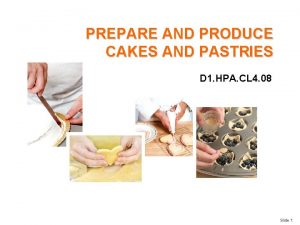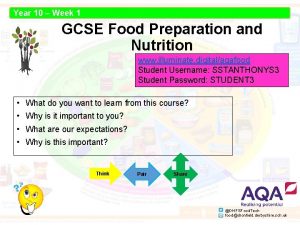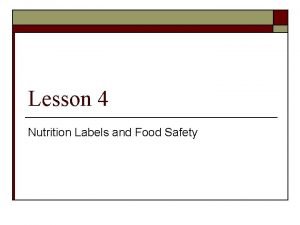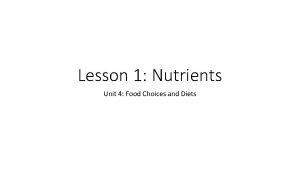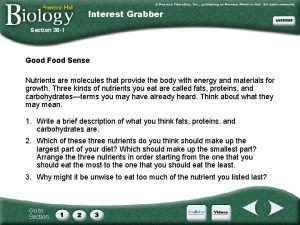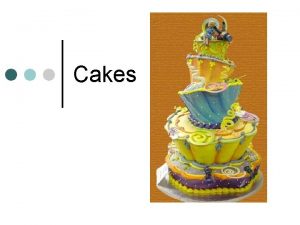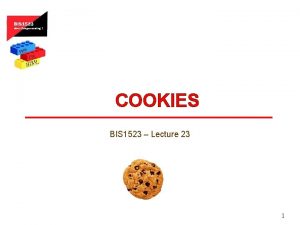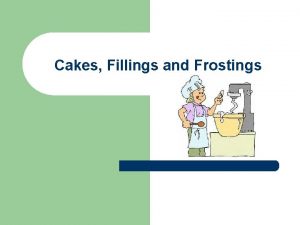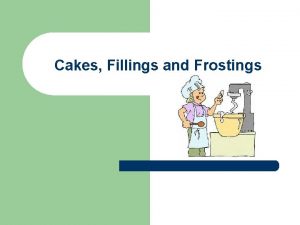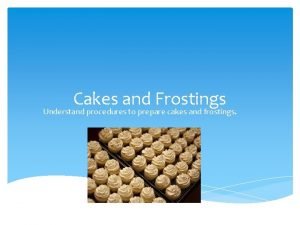Cookies Food Nutrition Cakes and cookies are similar











- Slides: 11

Cookies! Food & Nutrition

Cakes and cookies are similar in ingredients and proportions. The main difference is that cookies have relatively little liquid, giving them a more substantial texture. Despite the seemingly endless variety of cookies available today, cookies are conveniently grouped into six basic kinds based on how they are formed.

Baked in a shallow pan and cut into bars or squares Some are layered with different fillings, topping, or bases. Brownies are an example of a bar cookie. Bar cookies should be cut when cool; a thinbladed knife will make clean cuts. Removing a corner piece first makes the rest easier to remove. Bar Cookies

Chocolate chip cookies are an example. Made from soft dough and dropped on a cookie sheet A small cookie scoop comes in handy for drop cookies. Allow at least 2 inches between cookies since they spread during baking. Drop Cookies

Decorated holiday cookies are often rolled cookies. Made out of stiff dough that is rolled out and cut into different shapes with cookie cutters. Dough is chilled for easier handling. Roll the dough until it is 1/8 inch thick on a lightly floured surface. Rolled Cookies

Use as little flour as possible to avoid drying out the cookies. Before cutting, dip the cookie cutter in flour and shake off the excess. Using a spatula, place the cookies on a baking sheet about 1 inch apart. Rolled Cookies

Shaped by hand Balls of dough may be rolled in chopped nuts or coatings before baking. Some are flattened, engraved, or stamped before baking. Peanut butter cookies are an example. Chilling the dough makes the cookies easier to shape. Overworking the dough makes tough cookies. Place 1 inch apart on baking sheet, or 3 inches is they are to be flattened. Molded Cookies

Form dough into long, even rolls. Wrap the rolls in wax paper, foil, or plastic wrap, and chill according to the recipe. Dough can be prepared several days in advance. To cut, slice the roll by encircling it with heavy thread and pulling the ends. Place slices about 1 inch apart on a cookie sheet. Refrigerator Cookies

Made by using a cookie press to force dough directly onto a baking sheet. Spritz cookies are an example. Cookie presses include disks to make an array of shapes, from clovers to camels. The consistency of the dough is key to these cookies. It must be soft enough to press but firm enough to hold its shape. Some doughs are chilled, and working quickly is essential. Leave only about ½ inch between cookies. Pressed Cookies

◦ Cookies of uniform size bake more evenly. Let cookie sheets cool between batches. The dough softens and loses its shape on a hot sheet. ◦ Cookies are delicately brown when done. Unless the recipe says otherwise, remove the cookies from the sheet right when they are done and cool on a cooling rack. ◦ Store in an air-tight container. You can also freeze cookies for longer storage. Baking and Storing Cookies

Cookies can be made from a dry mix or can be found ‘ready-to-use’ in the refrigerator section. Convenience Cookies
 Mikael ferm
Mikael ferm Prepare and produce cakes and pastries
Prepare and produce cakes and pastries Similar disuelve a similar
Similar disuelve a similar Propiedades fisicoquímicas del agua
Propiedades fisicoquímicas del agua Similar
Similar Members of an avian species of identical plumage congregate
Members of an avian species of identical plumage congregate Illuminate aqa food preparation and nutrition
Illuminate aqa food preparation and nutrition Lesson 4 nutrition labels and food safety
Lesson 4 nutrition labels and food safety Food and nutrition unit 4
Food and nutrition unit 4 38-2 the process of digestion
38-2 the process of digestion Food and nutrition unit 5
Food and nutrition unit 5 Section 38-1 food and nutrition
Section 38-1 food and nutrition

